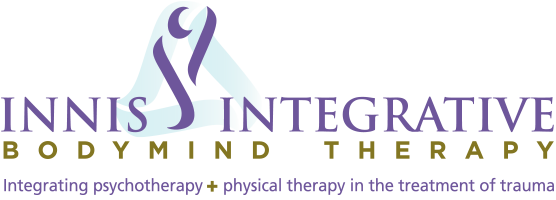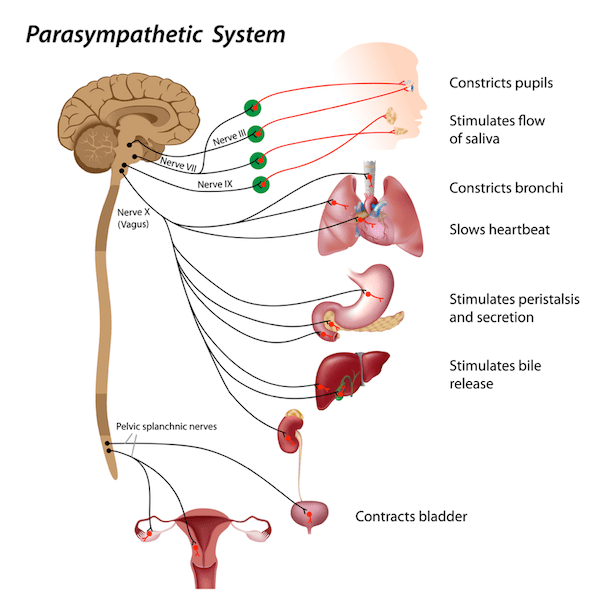Are you feeling a little out of control? Like you don’t know how to calm yourself down? Most of us do, at one time or another. Here are a few tips for learning how to self-soothe when it feels like your thoughts or body have taken over. That out of control feeling is usually associated with the sympathetic nervous system.
Our sympathetic nervous system is the part of our nervous system that mobilizes us into action. If our nervous system detects a threat, real or perceived, it will trigger our fight/flight/freeze response. If there isn’t a real threat, and we do not need the mobilization of our protective mechanisms, then we need to recruit our parasympathetic nervous system, which is the part that calms us down.
The vagus nerve is the most influential nerve in our parasympathetic nervous system. It functions like your body’s natural reset button. Learning how to stimulate your vagus nerve allows you to bring about the calm, collected feeling we all desire.
Watch this clip from YouTube to get a visual of how the vagus nerve begins to influence the rest and digest qualities of our parasympathetic nervous system.
Vagus means wandering in Latin. The nerve was named the “wandering” nerve for the meandering path it takes from the brain to all the organs in the chest and abdomen. It is the longest nerve in the body and it influences heart rate, respiration, and digestion.
It monitors activity in the liver, spleen, stomach, pancreases, heart, and lungs. The information from the vagus nerve is bidirectional, which means that the communication is from the brain down to the organs as well as from the organs up to the brain. In fact, most of the traffic in the vagus nerve (80 percent of its messages) travel upstream from the body to the brain.
Vagal Tone
The tone of the vagus nerve is significant to the activation of the parasympathetic nervous system. Heart rate variability is a way to measure vagal tone. As you breathe in, your heart-rate speeds up a little. As you breathe out, it slows down a little. The higher your vagal tone, the greater the difference between your inhalation heart-rate and your exhalation heart-rate. The higher the tone, the more efficient you are at relaxing.
Higher vagal tone is associated with better general health. It leads to better blood sugar regulation, reduced risk of stroke and cardiovascular disease, improved digestion and a reduction in migraines. Most importantly, it is associated with increased emotional stability, resiliency and longevity.
Lower vagal tone is associated with mood instability, depression, diabetes, chronic fatigue syndrome, cognitive impairment, chronic inflammation, and cardiovascular disease.
How To Activate Your Vagus Nerve
Slow, rhythmic, diaphragmatic breathing.
Splashing cold water on your face, or taking a cold shower, stimulates the dive reflex, which is associated with stimulating the vagus nerve. You can also achieve the same effect by holding a ziplock bag filled with ice cubes against your face and holding your breath. Or submerge your tongue in cold liquid.
Meditating.
Do yoga.
Humming, or making a “vooooooo” or “om” sound stimulates the vocal cords and facilitates long, slow, exhalation.
Valsalva Maneuver: Exhale against a closed airway by keeping your mouth closed and pinching your nose while trying to breathe out. It increases the pressure inside of your chest cavity thereby stimulating your vagus nerve.
Prosody, the act of speaking slowly, rhythmically and melodically as if you’re soothing a young child or pet.
Spend time in nature.
Think positive thoughts about other people.
Engage in positive social relationships.
Laugh out loud! I full belly laugh stimulates the vagus nerve and is contagious!
Engage in prayer.
Mild exercise stimulates gut flow and the vagus nerve.
Massages, even gently massaging around the carotid sinus located on the sides of your neck can stimulate the vagus nerve.
Gargling activates the vagus nerve by activating the muscles in the back of the throat while exhaling slowly.
Cultivate healthy intestinal bacteria, use probiotics.
Stimulating the vagus nerve stimulates the parasympathetic nervous system, which in turns reduces our neurophysiological experience of stress. It reduces our heart rate and blood pressure. It influences the limbic system in our brain, where emotions are processed. It stimulates digestion and creates an increased feeling of well-being. Start practicing the art of stimulating your vagus nerve to relieve anxiety, depression, tension and the general sense of unease when stress builds up. I invite you to practice daily as a preventive measure to ensure greater emotional resilience and improved health.
Click here for more information on PTSD Treatment
I invite you to contact me here for more information.




